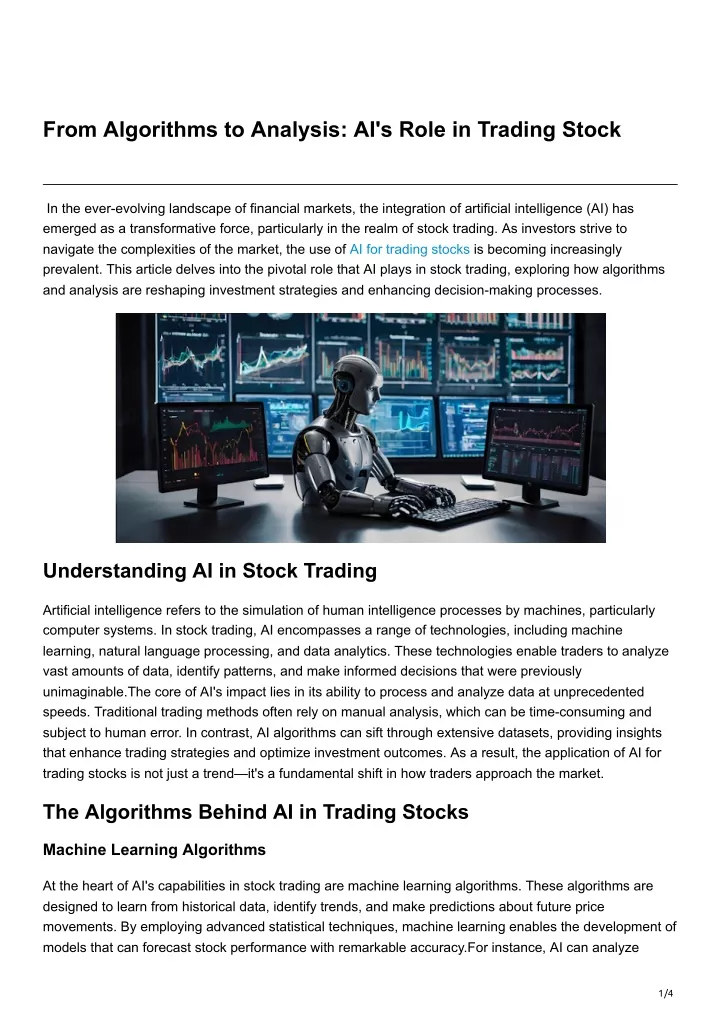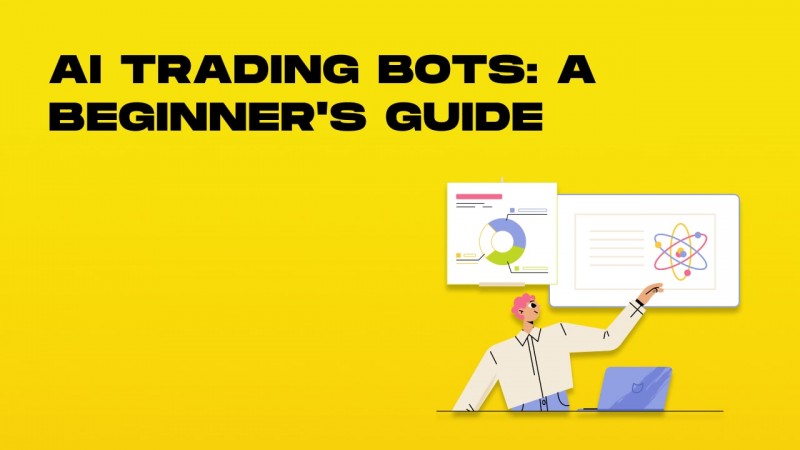20 Free Ways For Deciding On AI Stock Analysis Sites
20 Free Ways For Deciding On AI Stock Analysis Sites
Blog Article
Top 10 Tips For Taking A Look At The Cost And Price For Ai Stock Predicting/Analyzing Platforms
To get the best value, you must assess and price AI analysis and stock prediction platforms. Pricing can vary greatly and it's crucial to understand what you're getting value for your money. These are the top 10 tips for evaluating cost and price:
1. Learn about the pricing model
Subscription-based: Check whether the service charges per month or annually, and what features each tier includes.
Pay-per-use : Confirm that the platform charges according to the usage (e.g. transactions, requests for data, or forecasts).
Freemium model - Check whether there's a free version that has limited features and a premium version that includes premium features.
2. Compare Pricing Tiers
Compare features across each pricing level (e.g. professional, basic).
Scalability - Ensure that the pricing levels you choose to use are in line with your needs.
Upgrade flexibility: See whether you are able to upgrade or downgrade your plan as your requirements change.
3. Evaluate Hidden Costs
Data charges: Find out if you need to pay additional for access to premium data.
Brokerage costs Check to see whether the platform charges additional fees to execute trades or to integrate with brokers.
API usage: Check whether there are any additional charges to access APIs or frequent API usage.
4. Demos and Trials are available for free
Trial period: Select platforms that let you test out the features of their platform before making an investment.
Check the limitations on the free trial. It might not contain all of its features.
There is no commitment option If you do not like the service, you are able to unsubscribe at any time without cost.
5. Find discounts and special deals
Discounts on annual subscriptions The monthly plan is compared with an annual subscription.
Referral programs: Check if the platform provides discounts or credit for referring other users.
Prices for institutions: If you are a part of an organization that is larger than you, ask about pricing for bulk orders or institutions.
6. Review the Return on the investment
Cost vs. Value: Find out if the capabilities and forecasts of the platform justify its cost. For instance, can it assist you in making better decisions in trading or reduce time?
Performance track record - Check the platform's success rate or user testimonials for an indication of its potential ROI.
Cost alternatives - Compare the platform's cost to the possible cost if you don't use it (e.g. missed chance, analysis time manually).
7. Review and review cancellations and refunds Policies
You can unsubscribe at any point without being charged any penalties or fees.
Refund policy: Find out whether the platform allows refunds for unutilised portions of your subscription.
Auto-renewal (automatic renewal) Learn the reason you must renew your subscription on a regular basis. Also, find out how you can remove yourself from the subscription.
8. Pricing Transparency:
Clear pricing page: Ensure that the platform has transparent and clear pricing page with no fees hidden.
Customer support: Contact customer support to discuss any pricing issues or costs.
Contract Terms: Know the long-term obligations and penalties by studying the contract's terms.
9. Compare your competitors
Check out the features and prices on various platforms to find the most competitive price.
User reviews: Read feedback from the users about the platform and determine whether it's worth the money.
Market positioning: Find out if it is priced at an upper-end, mid-range or low-cost option, and if that aligns with your expectations.
10. Cost estimates for Long-Term
Price increases Look through the platform's history to find out how often it has raised prices.
Additions of features: Check whether your current plan contains new features or needs an upgrade.
Cost of scaling: The platform should be priced reasonably when your trading activities or data requirements increase.
Bonus Tips
Try a variety of platforms. Compare the effectiveness and performance of various platforms by testing their capabilities during free trials.
Discuss your price. If you're part of an institution or you're using this product in huge quantities, discuss pricing options that are custom.
You can find educational free tools on various platforms.
If you follow these guidelines You can easily evaluate the cost and pricing of AI stock predicting/analyzing trading platforms and ensure you select one that's within your budget and delivers the features and performance you want. A high-quality trading platform can achieve the ideal balance between affordability and features which will help you achieve the best results. Follow the most popular he said on ai for investment for blog advice including ai chart analysis, ai for stock trading, ai for stock predictions, options ai, options ai, ai investing platform, ai chart analysis, ai for stock predictions, AI stock market, investing ai and more.
Top 10 Tips For Assessing The Regulatory Compliance Of AI stock Predicting/Analyzing Platforms
Regulation compliance is an important element to evaluate trading platforms that use AI. Compliance assures that the system operates within the legal frameworks, safeguards personal data of its users and adheres to financial regulations, thus reducing the chance of legal issues or financial penalties. These are the top 10 tips for assessing regulatory compliance.
1. Verify licensing and registration
Regulators: Confirm that the website is licensed and registered by the appropriate financial regulatory authority (e.g. SEC, FCA, ASIC, etc.) in your nation.
Broker partnerships: If the platform integrates with brokers, make sure that brokers are also legally licensed and regulated.
Public Records: Go to the official website of your regulatory agency for details on registration status, past violations and other relevant data.
2. Assess Data Privacy Compliance
GDPR: Ensure that your platform adheres to the General Data Protection Regulation.
CCPA : California Consumer Privacy Act (CCPA) compliance should be checked by the users.
Policies on handling data: Read the policy on data privacy of the platform to ensure it outlines the ways in which user data is gathered, stored, and shared.
3. Review the Anti-Money Laundering(AML) measures
AML Policies The platform should be equipped with robust AML (Anti-Money Laundering) policies to identify money laundering and stop it from happening.
KYC procedures: Find out whether the platform supports Know Your Customer (KYC), which verifies user identities.
Monitor transactions: Determine if the platform monitors transactions for suspicious activities and if it reports it to the appropriate authorities.
4. Make sure you're in compliance with Trading Regulations
Market manipulation: Ensure that your platform has measures to stop market manipulations, like wash trading or fake trading.
Order types: Check if the platform is compliant with the regulations applicable to different types of orders (e.g. no illegal stop-loss hunt).
Best execution: Make sure the platform follows the highest standards of execution, and ensures that transactions are executed at the highest price available.
5. Assessment of Cybersecurity's compliance
Data encryption: Make sure that the platform is secure for user data both during its travel and also when it is at rest using encryption.
Incident response. Verify that there is clearly identified incident response plan on the platform to deal with cyberattacks as well as data breaches.
Certifications: Check if the platform is certified in cybersecurity (e.g., ISO 27001, SOC 2).
6. Transparency Evaluation and Transparency Evaluation and
Fee disclosure: Ensure the platform clearly discloses all fees, including any hidden or additional charges.
Risk disclosure: Ensure that the platform has disclosed all risks, particularly if you are using high-risk strategies or trading with leverage.
Performance reporting: Make sure the platform produces transparent and exact performance information to its AI model.
7. Check for conformity with international regulations.
Trading across borders: If you are trading internationally, make sure that the platform you use is in compliance with all regulations.
Tax reporting: Find out the platform's tools or reports for users to comply with tax regulations.
Sanctions compliance: Ensure that the platform adheres to international sanctions and does not allow trading only with countries or entities prohibited.
8. Assess Record-Keeping, Audit Trails
Transaction records: Ensure that the platform keeps detailed records of each transaction for reasons of auditing and regulatory purposes.
Recordings of user activity: Check whether the platform tracks user activity including logins or transactions as well as changes to the settings for your account.
Audit readiness: Make sure that the platform is able to provide all documentation and logs in case of the need for a regulatory audit arises.
9. Examine Compliance with AI-specific Regulations
Algorithmic trading rules: If you're using a platform that supports algorithmic trading, ensure it is compatible with relevant regulatory frameworks like MiFID II or Reg SCI which are in Europe and in the U.S.
Fairness and Bias: Make sure that the platform monitors and reduces biases within its AI models to ensure fair trading.
Explainability: As required by specific regulations, the system must provide clear explanations of AI-driven decisions and predictions.
Review the User Feedback and Regulatory Histories
Feedback from users: Read reviews from users to determine the credibility of the platform in terms of compliance with the law.
Historical Record: Search for violations in the past of regulations and penalties, fines or sanctions.
Third-party Audits: Make sure that the platform undergoes third-party reviews to ensure the platform is in compliance with all regulations.
Bonus Tips
Legal consultation: Consider consulting an expert in law to assess the platform's compliance with pertinent regulations.
Trial period: Take advantage of a demo free or trial to test compliance features on the platform.
Support for customers: Make sure the platform provides support for compliance-related queries or issues.
These tips will help you determine the level of compliance for AI trading platforms which can predict or analyze price of stocks. So you can select a platform that works within the legal frameworks and also protects you. Compliance does more than lower legal risks, but can also increase confidence in the platform. View the top trading ai tool url for site info including ai copyright signals, best AI stocks, best stock prediction website, ai options, AI stock investing, can ai predict stock market, best ai trading platform, trading ai tool, best stock prediction website, how to use ai for stock trading and more.